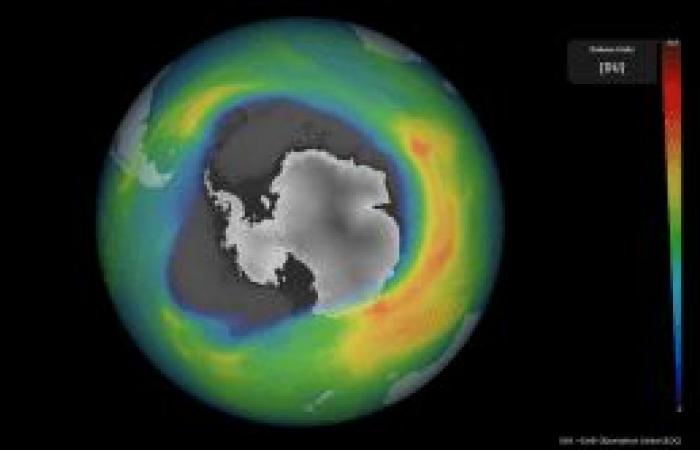That year, persistent cold temperatures and strong circumpolar winds (also known as polar vortices) contributed to the formation of a large and deep ozone hole in Antarctica just a year after scientists determined that 2019 was the smallest since the ozone hole was discovered in 1982, according to a report by NOAA and NASA scientists dated October 30, 2020.
The 2021 lunar calendars are here! Order yours before they’re gone. Makes a great gift!
The annual ozone hole in Antarctica – the twelfth largest on record – peaked at 24.8 million square kilometers on September 20, 2020, which is roughly three times the area of the continental United States.The scientists report that ozone is at a 6 km high The pillar of the stratosphere above the South Pole was almost completely eliminated. Diego Loyola from the German Aerospace Center said in a statement:
Our observations show that the 2020 ozone hole has grown rapidly since mid-August and covers most of the Antarctic continent, the size of which is well above average. It is also interesting that the 2020 ozone hole is also one of the deepest and has record-low ozone levels.
Ozone is a molecule made up of three oxygen atoms. An ozone layer high in the atmosphere – about 15 to 30 km high – surrounds the entire earth. It protects life on our planet from the harmful effects of the sun’s ultraviolet rays. In the 1980s, scientists began to realize that ozone-depleting chemicals like chlorofluorocarbons (CFCs) were forming a thin speck – a hole – in the ozone layer over Antarctica.
The size of the ozone hole over Antarctica fluctuates regularly. From August to October, during the late winter of the southern hemisphere, when the returning rays of the sun trigger ozone-depleting reactions, the ozone hole increases in size, reaching a maximum between mid-September and mid-October. When temperatures begin to rise in the southern hemisphere’s stratosphere, ozone depletion slows, the polar vortex weakens and eventually collapses, and by the end of December ozone levels will return to normal.
At 23.3 million square kilometers, the average size of the ozone hole was between September 7th and October 13th compared to other years. The 2020 ozone hole is the twelfth largest in terms of area. Image via NASA / NASA Ozone Watch / Katy Mersmann.
The ongoing decline in ozone-depleting chemicals controlled by the Montreal Protocol – the 1987 treaty to phase out substances responsible for ozone depleting – prevented the hole from being as big as it would have been decades ago under the same weather conditions as scientists. Paul A. Newman is the chief geosciences scientist at NASA’s Goddard Space Flight Center. He said in a statement:
Since the peak of 2000, the chlorine and bromine levels in the Antarctic stratosphere have fallen by around 16% to natural levels. We still have a long way to go, but this improvement made a huge difference this year. The hole would have been about a million square miles larger if there was still as much chlorine in the stratosphere as it was in 2000.
View larger. | Ozone concentration over Antarctica in the week of September 14-20, 2020. To enable year-to-year comparisons, experts define the “ozone hole” as the area in which the ozone level is below 220 Dobson units (dark blue, with a marked black triangle) color bar). Image via NOAA / Climate.gov.
Here’s more from NASA what the ozone hole is and why it matters:
Ozone consists of three oxygen atoms and is highly reactive with other chemicals. In the stratosphere, about 7 to 25 miles above the surface of the earth, the ozone layer acts like a sunscreen, protecting the planet from ultraviolet radiation, which can cause skin cancer and cataracts, suppress the immune system, and damage plants and delicate plankton at the base of the global food chain. In contrast, ozone, which is formed by photochemical reactions between the sun and pollution from vehicle emissions and other sources closer to the earth’s surface, creates harmful smog in the lower atmosphere.
The ozone hole in Antarctica forms in the late winter of the southern hemisphere, when the returning rays of the sun trigger reactions to deplete the ozone layer. Cold winter temperatures, which last into spring, allow ozone to break down, which is why the “hole” forms over the Antarctic. These reactions involve chemically active forms of chlorine and bromine derived from man-made compounds. The chemistry that leads to their formation involves chemical reactions that occur on the surfaces of cloud particles that form in cold layers of the stratosphere, ultimately leading to runaway reactions that destroy ozone molecules. At warmer temperatures, less polar stratospheric clouds form and they do not persist as long, which limits ozone depletion.
This animation shows the size of the ozone hole from September 25th to October 18th, 2020.
Learn more about NOAA and NASA’s efforts to monitor ozone and ozone-depleting gases
Conclusion: The 2020 Antarctic ozone hole is one of the largest and deepest in recent years.
About NASA
Via the World Meteorological Organization
About the ESA
These were the details of the news 2020 The Antarctic ozone hole is one of the largest and... for this day. We hope that we have succeeded by giving you the full details and information. To follow all our news, you can subscribe to the alerts system or to one of our different systems to provide you with all that is new.
It is also worth noting that the original news has been published and is available at de24.news and the editorial team at AlKhaleej Today has confirmed it and it has been modified, and it may have been completely transferred or quoted from it and you can read and follow this news from its main source.


